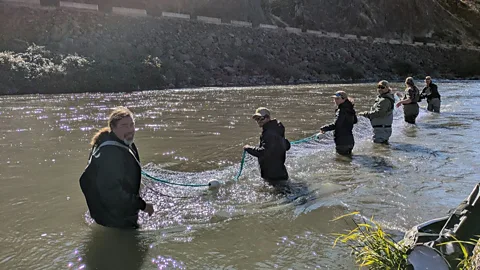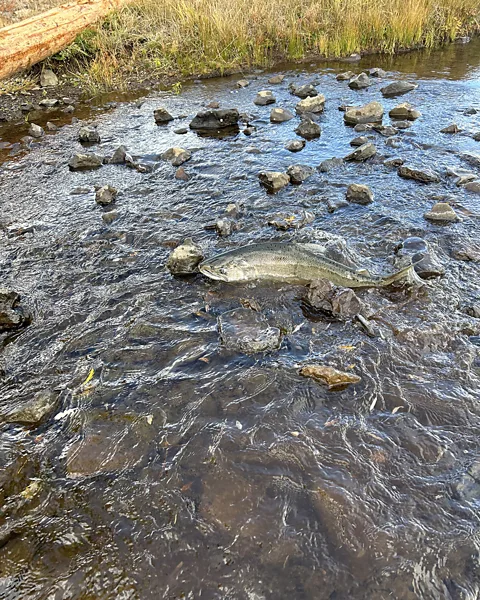After 100 years, salmon have returned to the Klamath River – following a historic dam removal project in California
 Damon Goodman
Damon GoodmanAfter being absent for more than a century, salmon have been spotted in Oregon's Klamath River Basin, following a mammoth dam removal project in California.
In October, fish biologists at Oregon Department of Fish and Wildlife identified an autumn-run Chinook salmon in a tributary to the Klamath River, upstream from where the J C Boyle Dam once stood. It is the first anadromous fish (species that migrate from the sea upstream to spawn) to be seen in the state's Klamath Basin since 1912 – when the first of four hydroelectric dams was constructed.
In August, the last of the four dams were demolished following an arduous campaign by tribal communities, who hoped the dam removal would lead to the return of salmon – a vital source of food for the tribes living alongside the Klamath River.
"We saw a large fish the day before rise to surface in the Klamath River, but we only saw a dorsal fin," says Mark Hereford, project leader for Oregon's Klamath fisheries reintroduction programme. "I thought, was that a salmon or maybe it was a very large rainbow trout?" The team returned the following two days and were "ecstatic" to confirm that salmon were in the tributary.
But the salmon have also made a surprising early return further downstream the Klamath River, on tribal lands.
"I thought that there would be some fish returning above the dams this year," says Barry McCovey, senior fisheries biologist for the Yurok Tribe. "But what's surprising is the sheer number of fish that are back, and the geographic range. I couldn't believe they'd been spotted in Oregon. It was incredible news to hear – it was mind boggling. When I heard, I was like 'wait, already?!' They've exceeded any expectations anyone had."
The headwaters of the Klamath River originate in Oregon, flowing through the Cascade Mountain Range, into Northern California, and emptying into the Pacific Ocean. Running 263 miles (423km), the river was once the third-largest salmon-producing river on the West Coast, and was a life force for numerous Native American tribes, such as the Yuroks – who are known as the "salmon people".
But the dams blocked fish migration, leading to mass fish die-offs and degraded water quality. Fall chinook salmon numbers plummeted by more than 90% compared to their pre-dam numbers and spring chinook by 98%. Steelhead trout, coho salmon and Pacific lamprey numbers also saw drastic declines, and the Klamath tribes in the upper basin have been without their salmon fishery for a century, since the completion of Copco 1 in 1922. Following a decades-long campaign by tribes, including the Yuroks and Karuks, the dams were demolished, with the last coming down in late August. The tribes are working with Oregon and California wildlife officials to monitor the return of anadromous fish, such as chinook and coho salmon, steelhead trout, and Pacific Lamprey to the Klamath basin post-dam removal. Many weren't expecting to see the return of fish for years but biologists in California have also seen salmon in creeks that were formerly inaccessible when the dams were in place.
"The fish are spawning in these tributaries that nine months ago were 30ft (9.1m) underwater. It offers so much hope for the future," says McCovey. "It makes me feel that we did the right thing, we're on the right path. The river is healing itself."
The dismantling of the dams was the largest dam-removal project in US history. The dams had been extremely unpopular with local tribes, who had campaigned for their removal since at least the 1990s. "We were told it was never going to happen," says Brook Thompson, a Yurok tribal member and civil engineer who is involved in restoring the Klamath basin. "We were told it was foolish to even ask for one removal – we were asking for four."
 Oregon Department of Fish and Wildlife
Oregon Department of Fish and WildlifeFollowing years of failed negotiations, work started on removing the four California dams in 2023, and in August 2024, to the joy of local tribes, the final dam fell. It reopened more than 400 miles (644km) of river.
"Salmon returning to the upper Klamath River the same season as the dam removal has filled me with gratification and joy that I usually reserve for weddings and births," says Thompson. "Seeing the videos of the salmon returning home brought me to tears of happiness and relief. We did it. I am filled with newfound energy and hope to keep up my work in restoration and supporting the rights of tribes and fish."
The Yurok Tribe's goal is to eventually restore the thriving salmon fishery they once had, and be able to host their annual salmon festival in August– with Klamath salmon, rather than having to import it from Alaska.
More like this:
• How restoring rivers' curves prevents flooding
"Tribes will continue to support the salmon as they have supported us all these generations," adds Thompson. "My dream is that one day, my future descendants will be able to live the reality that my grandfather experienced in the early 1900s by seeing so many salmon he could walk across their backs to the other side."
The tribe is also restoring 2,200 acres (890ha) of land that is above ground for the first time in a century following the emptying of the four reservoirs.
"There'll be ups and downs, there won't be a straight line, we'll have setbacks," says McCovey. "Any restoration project this big does. We know it won't be easy, but that's ok, we've dealt with that before and we're just looking to the future."
--
If you liked this story, sign up for The Essential List newsletter– a handpicked selection of features, videos and can't-miss news, delivered to your inbox twice a week.
